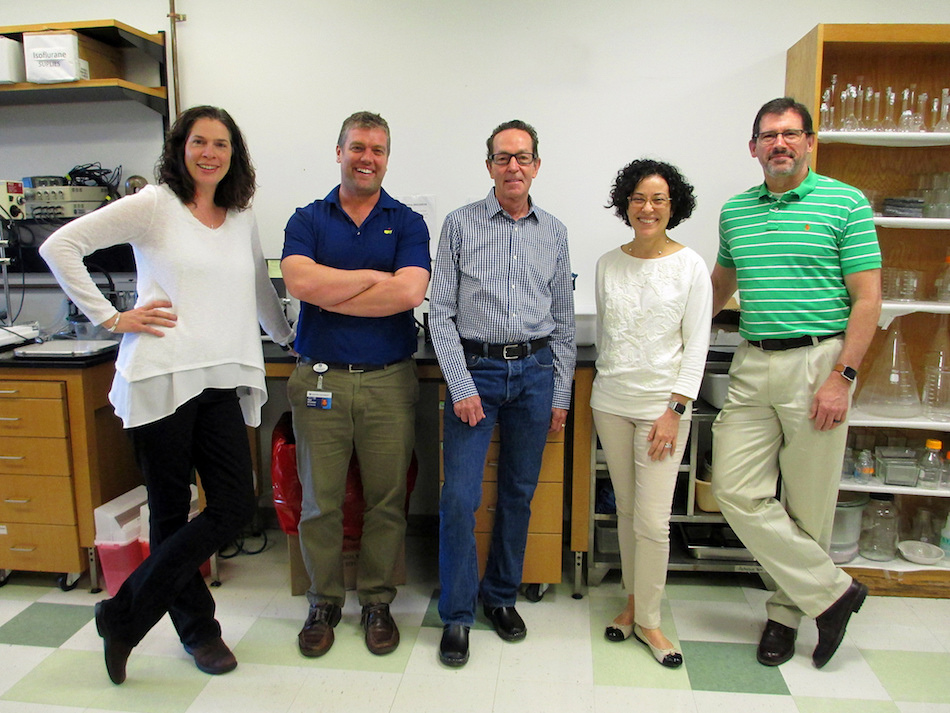It’s been known for decades that a bacterial infection can raise your blood pressure short term, but now scientists are putting together the pieces of how our own dying cells can fuel chronically high, destructive pressure.
Quite literally billions of our cells die daily and their remains are mostly taken up by garbage-eating immune cells like macrophages. But scientists have increasing evidence that when cell carnage increases because of high blood pressure, the mounting debris also gets the attention of our immune system, causing inflammation and blood vessel constriction that contributes to worsening hypertension.
“It’s a circle,” said Dr. R. Clinton Webb, chairman of the Department of Physiology at the Medical College of Georgia at Augusta University, in which inflammation is a constant and, which isn’t addressed in today’s treatment regimens.
“The more blood pressure goes up, the more injury you have,” said Webb, and he and his colleagues want to understand the signaling pathways that are driving this inflammation that further drives blood pressure.
Webb, a vascular expert, is principal investigator on a $9.4 million Program Project Grant from the National Heart, Lung and Blood Institute, that will further parse how contents regularly split from a surplus of dying cells contribute to this unhealthy and seemingly vicious circle.
While the chicken or the egg question isn’t answered, it’s clear that higher blood pressure – from causes like obesity to genetics to salt sensitivity – increases cell death. Once outside the dying cell, typical contents like DNA as well as HMGB1, which helps stabilize the DNA, are categorized as damage associated molecular patterns, or DAMPs.
The scientists call DAMPs “alarm signals” because they look like bacterial or viral invaders to the immune system. That sets in motion likely well-intended inflammation to fight the invader but blood-vessel constriction and narrowing, kidney and other organ damage, and more cell death also follow.
The new grant is enabling Webb and his team to look at what happens when the increased cell carnage inside blood vessel walls increases the release of DNA from cell powerhouses called mitochondria – DNA which actually is distinctly different from our own.
Project leaders Drs. Jennifer Sullivan and Paul O’Connor, respectively, are exploring how the different ways cells die in males and females impact the damage that follows the release of HMGB1, and how an onslaught of these and other DAMPs cripple the kidney’s ability to help regulate blood pressure.
Dr. Adviye Ergul, vascular physiologist, is managing the bioinflammation core, and Dr. Michael Brands, cardiovascular-renal physiologist, is managing the animal use and instrumentation core for the five-year studies to ensure the consistency of results gathered and minimal animal usage.
Hypertension affects about one third of the adult population in the United States, according to the Centers for Disease Control and Prevention, and Webb thinks DAMPs are both the result of and initiators of hypertension in many.
“Cells are dying all over if you have hypertension,” Sullivan said. Smooth muscle cells and endothelial cells that comprise the blood vessels are definite casualties. “There is no doubt there are more dead cells in the hypertensive blood vessel,” Webb said.
All this internal debris has to go somewhere and some finds its way into nearby cells. There it can activate immune receptors that instead of just consuming it, mount a fight that further damages the form and function of blood vessels and organs, Webb said.
Like bacteria, DAMPs activate Toll-like receptors, or TLRs, that can be found inside many cells and outside others, although they are known to translocate. The nine different types of TLRs also have in common some degree of activation of MYD88, a downstream molecule, which in turn activates transcription factor NF-kB, which helps control gene expression as well as cell death and growth. In the case of activation by DAMPs, TLRs initiate inflammation, a good reaction when, for example, TLR4 responds as it should to a membrane component of bacteria.
But Webb’s team is focusing on what happens inside blood vessels when excessive cell death leads to excessive release of the mitochondrial DNA. Even with its foreign DNA, as with other DAMPs, all is fine until mitochondrial DNA gets spilled. At that moment it can start to activate TLR9s inside immune, vascular smooth muscle or endothelial cells, Webb said. One of the many questions the researchers want to answer is whether TLR4 and TLR9 have some unfortunate inflammatory synergy through their activation of MYD88 in this scenario.
The long-term goal of Webb and his colleagues: identifying targets that could block some of the unintended results without putting people at risk for additional disease by generally suppressing their natural immune response.
“Imagine, for example, if you could figure out a drug that would actually block say the uptake of mitochondrial DNA,” Webb said. Or, in the case of Sullivan, a pharmacologist and physiologist, a drug that reduces excessive activation of T-cells, the drivers of the immune response.
“There is this growing interest in the adaptive immune response and T cells being important in causing increases in hypertension,” Sullivan said of a finding that has been shown in animal models and people. “There is evidence of T-cell activation, but what is causing it?” Knowing that answer could lead to treatment that selectively blocks excess activation, so the scientists are looking upstream for activators.
Like most things in the body, there are balances, in this case effector T cells that promote inflammation and Tregs that reduce it. Effector T cells are definitely a contributor to hypertension and DAMPs are likely one of their activators, particularly in males, Sullivan said.
High blood pressure tends to kill cells in males through necrosis, in which cells essentially burst open. At least before the age of menopause, females experience more apoptosis, or programmed cell death, a natural, cleaner approach to cell elimination that better contains their innards.
“The way a cell dies is important, and the males are releasing things to a greater degree,” Sullivan said. On the other hand, apoptosis, in which the cell engulfs itself, is actually anti-inflammatory, and appears instead to attract calming Tregs. Sullivan and her team have watched this scenario play out in isolated kidney and heart cells.
“Both sexes are becoming hypertensive but it doesn’t mean they are taking the same path to get there,” she said. And, if they can learn more about the differences – along with any common ground – they can devise more effective treatment for at least a segment of patients with hypertension.
The new grant also is enabling a further look at how cells die in males versus female hypertensive rats. Also, when scientists inhibit each cell death method, what that does to blood pressure regulation as well as which T cells get activated. While Sullivan isn’t certain she could or would make the males apoptose, right now she wants to know more about which cells are dying in the kidneys, how they are dying and what immune response gets activated as a result in the males versus females. A future goal may instead be inhibiting necrosis in males.
One of the many things necrosis dumps, and the scientists are following, is the molecule HMGB1. Outside the cell, this DNA stabilizer gets the attention of the immune system, in this case, TLR4. Their theory and early evidence indicates more HMGB1 is dumped in the males than in their female counterparts.
O’Connor, a renal physiologist, is also focusing on the kidneys. He wants to test the hypothesis that high levels of DAMPs interfere with the critical work of the middle portion of the kidney. This renal medulla, which is directly linked to the tubules which collect urine, is critical to concentrating urine so you can still eliminate salt and other byproducts, particularly when you are not consuming enough liquid.
O’Connor likens the renal medulla to a sand pit for salt and the unique long, thin-walled U-shaped blood vessels help ensure that all salt – which the kidneys use to help regulate fluid volume and blood pressure – is not lost.
However, the odd vascular configuration that O’Connor calls an “Achilles heel” also makes the blood vessels susceptible to clogging. “We think they are always susceptible to getting clogged up. The red blood cells have a tendency to get trapped in there,” he said.
There appears to be a sort of traffic circle to help keep things moving because these blood vessels are lined by tiny contractile cells called pericytes that O’Connor calls “24 plumbers on demand.” He and his team are exploring whether DAMPs interfere with the pericytes’ ability to contract, enabling a pileup that interferes with kidney function and further drives up blood pressure.
“We think DAMPs might hamper this contraction and allow red blood cells to get stuck. As that slowly happens, it changes the kidney function and contributes to high blood pressure,” O’Connor said. They know this happens with the odd-shaped red blood cells of sickle cell disease. Their pursuits include exploring whether endothelial cells that line the unusual vasculature are stimulated by DAMPs to make more of the blood vessel dilator nitric oxide, which weakens the contractility of pericytes.
If the theory and early evidence hold, drugs that support the contractile cells could enable the kidneys to remain helpful in avoiding hypertension, rather than worsening it. The researchers note the vast capacity of the kidneys to support us, and that related problems typically do not become apparent until about 80 percent of function is lost.
“We are trying to identify whether DAMPs play a role in the hypertensive process. I think that is the fundamental question,” Webb said of the extensive studies ahead.
In a related study recently added to the already long list, Webb is collaborating with Dr. Kebin Liu, cancer immunologist in the MCG Department of Biochemistry and Molecular Biology and the Georgia Cancer Center, to explore the fact that hypertension also is emerging as the most common comorbidity – which is collateral damage essentially – of chemotherapy.
Like high blood pressure, cancer drugs increase cell death and resulting cellular debris, including DAMPs, again appear to catch the attention of the immune system. Cancer patients may later find themselves with hypertension and other cardiovascular damage. So Webb and Liu are giving rats tumors, treating them with chemotherapy and then looking at what happens to their blood vessels to further clarify the association. They note that cancer and cardiovascular trouble such as hypertension share some risk factors like smoking and obesity.
Webb noted that a burned tongue from a hot cup of morning coffee that is mostly better by that afternoon illustrates normal cell death and typically rapid recovery. It’s when diseases such as hypertension start killing off an excessive number of cells throughout the body, that normal compensatory mechanisms become overwhelmed. Age makes us less able to cope with increased debris from dying cells.
 Augusta University
Augusta University




